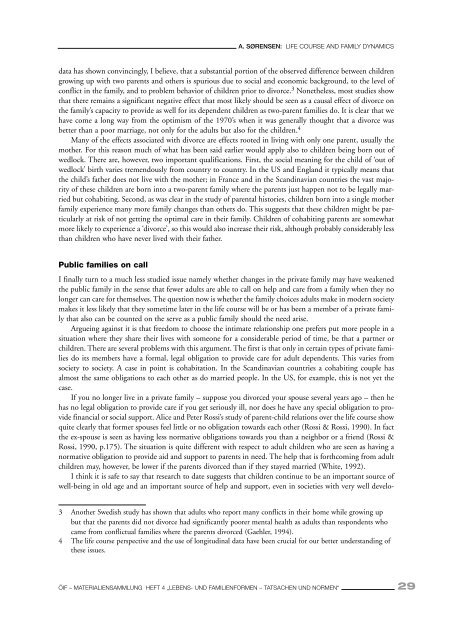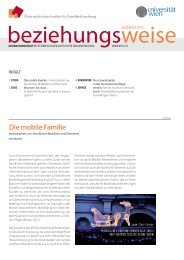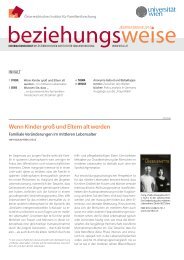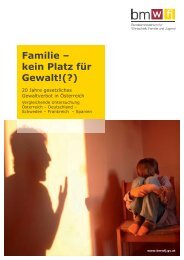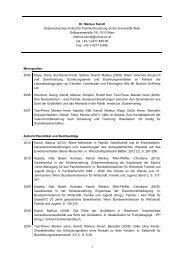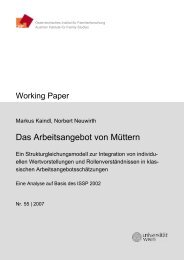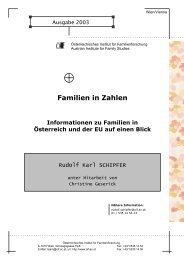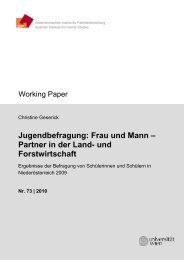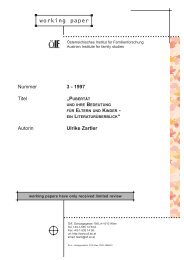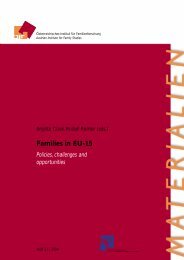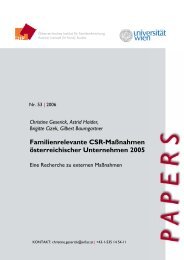Lebens- und Familienformen - Tatsachen und Normen
Lebens- und Familienformen - Tatsachen und Normen
Lebens- und Familienformen - Tatsachen und Normen
Erfolgreiche ePaper selbst erstellen
Machen Sie aus Ihren PDF Publikationen ein blätterbares Flipbook mit unserer einzigartigen Google optimierten e-Paper Software.
A. SØRENSEN: LIFE COURSE AND FAMILY DYNAMICS<br />
data has shown convincingly, I believe, that a substantial portion of the observed difference between children<br />
growing up with two parents and others is spurious due to social and economic backgro<strong>und</strong>, to the level of<br />
conflict in the family, and to problem behavior of children prior to divorce. 3 Nonetheless, most studies show<br />
that there remains a significant negative effect that most likely should be seen as a causal effect of divorce on<br />
the family’s capacity to provide as well for its dependent children as two-parent families do. It is clear that we<br />
have come a long way from the optimism of the 1970’s when it was generally thought that a divorce was<br />
better than a poor marriage, not only for the adults but also for the children. 4<br />
Many of the effects associated with divorce are effects rooted in living with only one parent, usually the<br />
mother. For this reason much of what has been said earlier would apply also to children being born out of<br />
wedlock. There are, however, two important qualifications. First, the social meaning for the child of ‘out of<br />
wedlock’ birth varies tremendously from country to country. In the US and England it typically means that<br />
the child’s father does not live with the mother; in France and in the Scandinavian countries the vast majority<br />
of these children are born into a two-parent family where the parents just happen not to be legally married<br />
but cohabiting. Second, as was clear in the study of parental histories, children born into a single mother<br />
family experience many more family changes than others do. This suggests that these children might be particularly<br />
at risk of not getting the optimal care in their family. Children of cohabiting parents are somewhat<br />
more likely to experience a ‘divorce’, so this would also increase their risk, although probably considerably less<br />
than children who have never lived with their father.<br />
Public families on call<br />
I finally turn to a much less studied issue namely whether changes in the private family may have weakened<br />
the public family in the sense that fewer adults are able to call on help and care from a family when they no<br />
longer can care for themselves. The question now is whether the family choices adults make in modern society<br />
makes it less likely that they sometime later in the life course will be or has been a member of a private family<br />
that also can be counted on the serve as a public family should the need arise.<br />
Argueing against it is that freedom to choose the intimate relationship one prefers put more people in a<br />
situation where they share their lives with someone for a considerable period of time, be that a partner or<br />
children. There are several problems with this argument. The first is that only in certain types of private families<br />
do its members have a formal, legal obligation to provide care for adult dependents. This varies from<br />
society to society. A case in point is cohabitation. In the Scandinavian countries a cohabiting couple has<br />
almost the same obligations to each other as do married people. In the US, for example, this is not yet the<br />
case.<br />
If you no longer live in a private family – suppose you divorced your spouse several years ago – then he<br />
has no legal obligation to provide care if you get seriously ill, nor does he have any special obligation to provide<br />
financial or social support. Alice and Peter Rossi’s study of parent-child relations over the life course show<br />
quite clearly that former spouses feel little or no obligation towards each other (Rossi & Rossi, 1990). In fact<br />
the ex-spouse is seen as having less normative obligations towards you than a neighbor or a friend (Rossi &<br />
Rossi, 1990, p.175). The situation is quite different with respect to adult children who are seen as having a<br />
normative obligation to provide aid and support to parents in need. The help that is forthcoming from adult<br />
children may, however, be lower if the parents divorced than if they stayed married (White, 1992).<br />
I think it is safe to say that research to date suggests that children continue to be an important source of<br />
well-being in old age and an important source of help and support, even in societies with very well develo-<br />
3 Another Swedish study has shown that adults who report many conflicts in their home while growing up<br />
but that the parents did not divorce had significantly poorer mental health as adults than respondents who<br />
came from conflictual families where the parents divorced (Gaehler, 1994).<br />
4 The life course perspective and the use of longitudinal data have been crucial for our better <strong>und</strong>erstanding of<br />
these issues.<br />
ÖIF – MATERIALIENSAMMLUNG HEFT 4 „LEBENS- UND FAMILIENFORMEN – TATSACHEN UND NORMEN“ 29


